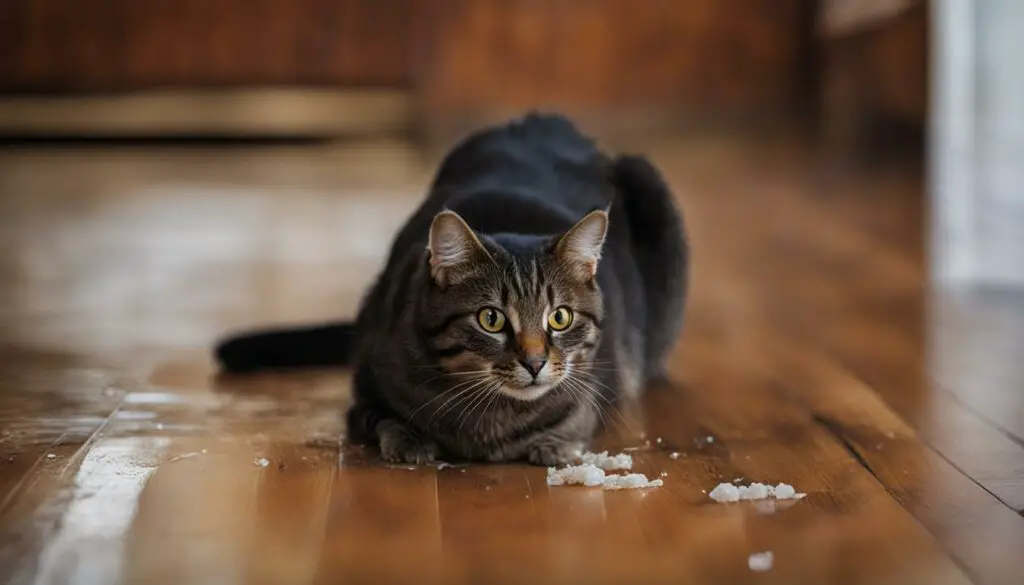Welcome to our article on one of the most frustrating behaviors reported by cat owners – when a cat keeps pooping on the floor in the same spot. If you’re dealing with this issue, you’re not alone. It’s a common problem that can be caused by various factors. In this article, I will address some of the most common queries related to this behavior and provide insights on how to resolve it.
Key Takeaways
- House soiling is a common behavior problem reported by cat owners.
- Cats may eliminate outside the litter box due to medical problems, litter box aversions, inappropriate site preferences, or territorial marking.
- Identifying the underlying cause is crucial in finding a solution.
Common Reasons for Cats Eliminating Outside the Litter Box
Cats eliminating outside the litter box can be a frustrating issue for cat owners to deal with. However, understanding the common reasons behind this behavior can help in finding a solution. Cats may eliminate outside the litter box due to medical problems, litter box aversions, inappropriate site preferences, or territorial marking.
Medical problems can be a significant cause of cats eliminating outside the litter box. Urinary tract infections, gastrointestinal issues, and arthritis can make it painful or difficult for cats to use the litter box. It is important to rule out any underlying medical conditions and seek veterinary advice.
Litter box aversions are another common reason for cats eliminating outside the litter box. Cats may dislike the litter or its location, leading them to find alternative spots to eliminate. Similarly, inappropriate site preferences occur when a cat prefers a particular surface or location over the litter box. Understanding these preferences and making appropriate changes can encourage proper litter box usage.
Table: Common Reasons for Cats Eliminating Outside the Litter Box
| Reason | Description |
|---|---|
| Medical Problems | Urinary tract infections, gastrointestinal issues, and arthritis can make it painful or difficult for cats to use the litter box. |
| Litter Box Aversions | Cats may dislike the litter or its location, leading them to eliminate outside the litter box. |
| Inappropriate Site Preferences | Cats may have a preference for a specific surface or location, causing them to eliminate outside the litter box. |
| Territorial Marking | Cats may eliminate outside the litter box as a form of territorial marking. |
Territorial marking is another natural behavior exhibited by cats. When cats feel the need to establish or maintain their territory, they may spray urine on vertical surfaces. This behavior is more common in unneutered males, but both males and females can exhibit territorial marking. Understanding the underlying reasons behind this behavior can help in addressing it effectively.
By identifying the common reasons for cats eliminating outside the litter box, cat owners can take appropriate steps to resolve this behavior. It is crucial to address any medical issues, make necessary changes to the litter box setup, and provide an environment that meets the cat’s needs. With patience and positive reinforcement, cats can be encouraged to use the litter box consistently, improving their hygiene and overall well-being.
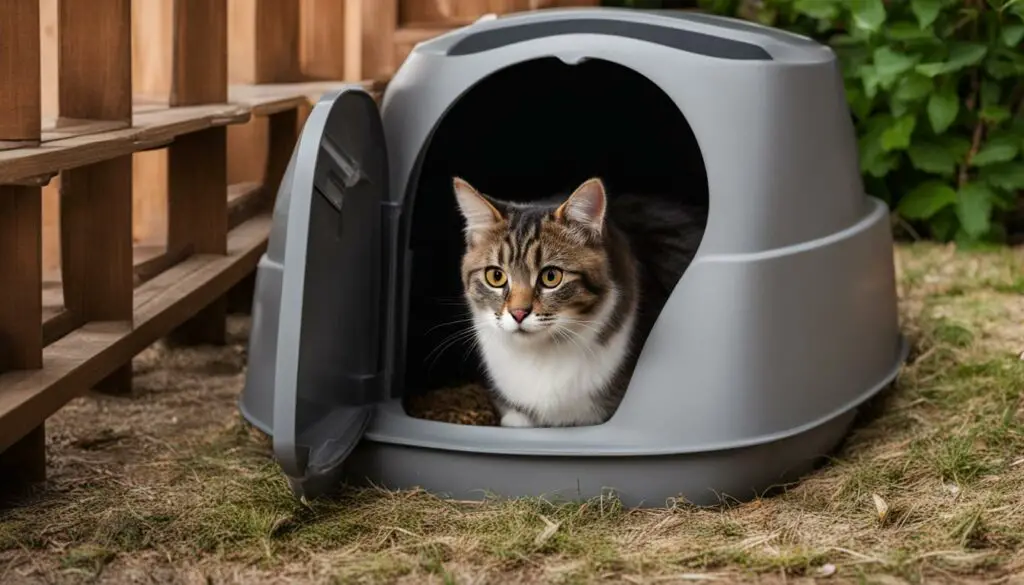
Medical Problems and Litter Box Issues
When cats start eliminating outside the litter box, it can be a sign of underlying medical problems. Conditions such as urinary tract inflammation, kidney and thyroid diseases, diabetes mellitus, and digestive tract problems can all contribute to litter box issues. Cats may associate pain or discomfort with using the litter box and choose to eliminate elsewhere.
Age-related diseases that affect mobility or cognitive functions can also lead to accidents. It’s essential to identify and treat any medical conditions to resolve litter box problems effectively.
Medical Conditions That Contribute to Litter Box Issues
Here’s a breakdown of some medical problems commonly associated with litter box issues:
| Medical Condition | Symptoms |
|---|---|
| Urinary Tract Inflammation | Frequent urination, straining to urinate, blood in urine |
| Kidney Disease | Increased thirst, increased urination, weight loss |
| Thyroid Disease | Increased appetite, weight loss, restlessness |
| Diabetes Mellitus | Increased thirst, increased urination, weight loss |
| Digestive Tract Problems | Vomiting, diarrhea, poor appetite |
By addressing and treating these medical conditions, cats can be relieved of any pain or discomfort associated with using the litter box, leading to improved litter box habits.
Litter Box Aversions and Inappropriate Site Preferences
Cats may develop aversions to the litter box due to various factors, including the box itself, the type of litter used, or the location of the litter box. A cat with a litter box aversion may choose to eliminate on soft or hard surfaces instead of using the litter box. Additionally, cats may have inappropriate site preferences, preferring a specific surface or location for elimination. This can include carpeted areas, rugs, or even certain rooms in the house.
To address litter box aversions and inappropriate site preferences, it’s important to understand the underlying reasons behind these behaviors. Some cats may dislike the texture or smell of certain types of litter, while others may find the litter box to be in an unfavorable location, such as a busy or noisy area of the house. Addressing these issues can help encourage proper litter box usage.
“Understanding the underlying reasons behind a cat’s litter box aversions or inappropriate site preferences is the key to finding a solution,” says Dr. Sarah Johnson, a veterinarian specializing in feline behavior. By identifying and addressing these factors, you can improve your cat’s litter box habits and prevent accidents.
One approach to resolving litter box aversions is to experiment with different types of litter. Cats have individual preferences when it comes to litter texture and scent. By offering a variety of litter options, such as clumping clay, unscented, or natural alternatives like pine or paper pellets, you can find the one that your cat prefers. Similarly, if your cat dislikes the location of the litter box, consider moving it to a quieter and more secluded area of the house.
Creating a Positive Litter Box Environment
Creating a positive litter box environment is essential in encouraging proper litter box usage. This includes keeping the litter box clean by scooping it daily and completely changing the litter on a regular basis. Cats are clean animals and may avoid a dirty litter box. Additionally, providing multiple litter boxes in different areas of the house can address issues with inappropriate site preferences.
Remember, each cat is unique, and it may take some trial and error to find the right solutions for your feline friend. Patience, consistency, and understanding their individual preferences will go a long way in resolving litter box aversions and inappropriate site preferences.
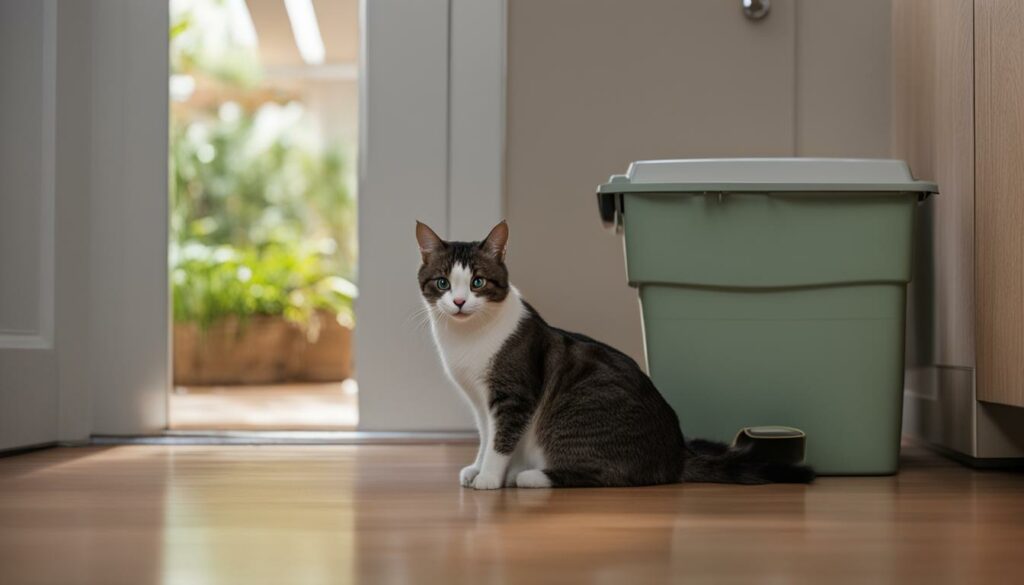
Understanding Urine Spraying as a Form of Territory Marking
Urine spraying is a natural behavior in cats that serves as a form of territory marking. By depositing small amounts of urine on vertical surfaces, cats communicate their presence and establish territorial boundaries. This behavior is more commonly observed in intact (non-neutered or non-spayed) cats, but spayed and neutered cats can also exhibit spraying behavior.
Urine spraying is often triggered by factors that threaten a cat’s territory, such as the presence of other animals or changes in the household environment. It can also be a response to frustration or anxiety. Understanding the reasons behind urine spraying is essential in addressing this behavior effectively.
One way to differentiate urine spraying from other forms of house soiling is to observe the behavior. Cats typically adopt a specific stance with their tail held upright and quivering while spraying. They target vertical surfaces such as walls, furniture, or doorways. The distinctive scent of sprayed urine, which is stronger and more pungent than that of regular urination, can also be an indicator of this behavior.
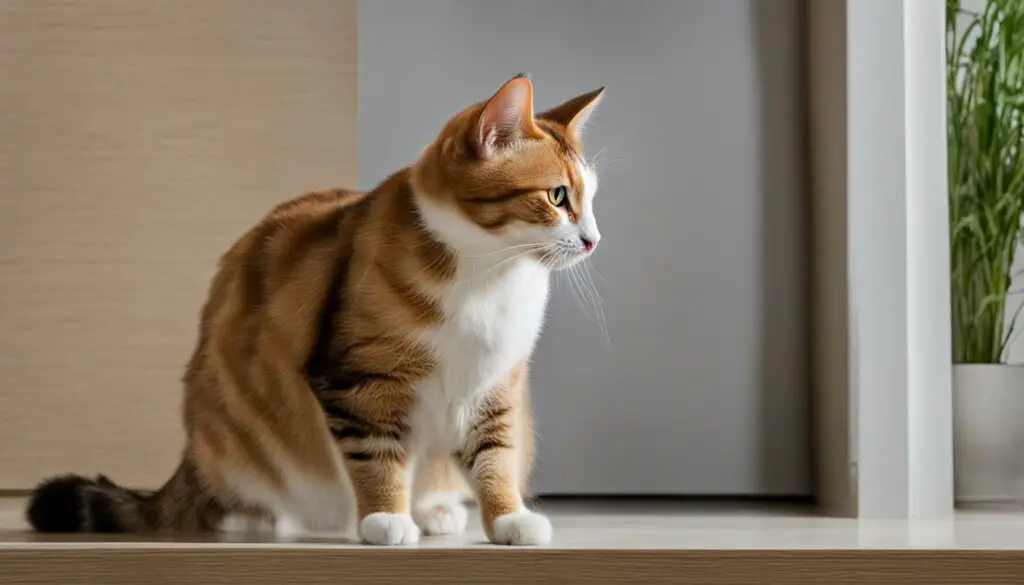
Quote:
“Urine spraying is a natural marking behavior in cats. They deposit small amounts of urine on vertical surfaces to establish or maintain territorial boundaries.”
Table: Comparison of Urine Spraying and Regular Urination
| Aspect | Urine Spraying | Regular Urination |
|---|---|---|
| Posture | Upright tail with quivering | Normal posture with tail down |
| Target | Vertical surfaces (walls, furniture) | Litter box or designated area |
| Quantity | Small amounts | Typical urination volume |
| Scent | Strong and pungent | Normal urine scent |
| Triggers | Presence of other animals, changes in environment | N/A |
Addressing urine spraying involves identifying and addressing the underlying triggers. Providing a stress-free environment, reducing conflict with other animals, and providing vertical scratching posts or perches can help alleviate territorial disputes. Environmental enrichment, such as interactive toys and regular playtime, can also help reduce anxiety. In some cases, consulting with a veterinarian or a professional animal behaviorist may be necessary to develop a tailored behavior modification plan.
It’s important to note that punishment is not an effective solution for urine spraying. Punitive measures can increase stress and potentially worsen the behavior. Instead, positive reinforcement and reward-based training techniques should be used to encourage desired behaviors, such as using the litter box consistently.
Steps to Stop Litter Box Problems
When dealing with litter box problems, it’s important to take immediate action to prevent them from becoming a habit. Here are some steps you can take to stop litter box problems and encourage your cat to use the litter box consistently:
- Clean the litter box regularly: Cats prefer clean litter boxes, so scooping the box daily and completely changing the litter at least once a week can help. Make sure to use unscented litter, as some cats dislike strong odors.
- Provide multiple litter boxes: If you have multiple cats, each cat should have its own litter box, plus one extra. This helps prevent territorial disputes and ensures that each cat has easy access to a litter box whenever needed.
- Location, location, location: Place the litter box in a quiet and easily accessible area. Avoid placing it near loud appliances, in high-traffic areas, or in places where your cat may feel trapped or cornered.
- Address litter box aversions: If your cat has developed an aversion to the litter box, experiment with different types of litter and litter boxes to find one that your cat prefers. Some cats may prefer open litter boxes, while others may prefer covered ones.
- Reduce stress: Stress can contribute to litter box problems, so creating a calm and stress-free environment for your cat is essential. Provide plenty of hiding spots, vertical spaces, and playtime to keep your cat mentally and physically stimulated.
Remember, solving litter box problems requires patience and consistency. If these steps don’t resolve the issue, consult with your veterinarian to rule out any underlying medical conditions and to discuss additional strategies for managing the behavior.

Table: Common Mistakes to Avoid when Addressing Litter Box Problems
| Mistake | Consequence |
|---|---|
| Using punishment | Can lead to fear and anxiety, exacerbating the problem. |
| Ignoring medical causes | Untreated medical conditions can perpetuate litter box problems. |
| Inconsistent cleaning | Dirty litter boxes can deter cats from using them. |
| Not providing enough litter boxes | Can lead to territorial disputes and restricted access. |
| Moving the litter box abruptly | Can confuse or stress the cat, resulting in accidents. |
Identify the Cause of Litter Box Problems
To address litter box problems effectively, it is essential to identify the underlying cause. By understanding why your cat is eliminating outside the litter box, you can implement appropriate solutions and encourage proper litter box use.
Observe Preferences
Start by observing your cat’s preferences for certain surfaces or locations. Some cats may prefer soft surfaces like carpet or hard surfaces like tile. By noting these preferences, you can modify the litter to match their preferences or provide alternative litter boxes with different materials.
Consider Litter Box Size and Placement
The size and placement of the litter box can also contribute to litter box problems. Make sure the litter box is large enough for your cat, especially if they are a larger breed, a kitten, or an elderly cat. Additionally, ensure that the litter box is easily accessible and located in a quiet and low-traffic area.
Address Social Factors
Social factors can also play a role in litter box problems. Cats may have aversions to sharing the litter box with other animals or may be stressed by the presence of other cats or dogs in the household. If you have multiple cats, providing each cat with their own litter box can help alleviate these issues.
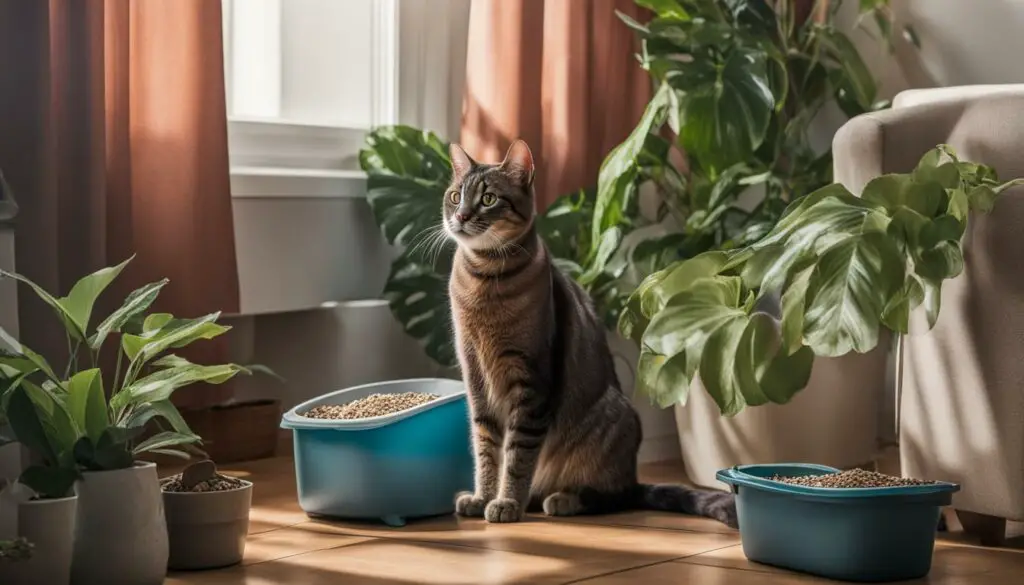
By identifying the cause of your cat’s litter box problems, you can implement targeted solutions to address the issue. Whether it’s modifying the litter, adjusting the size and placement of the litter box, or addressing social factors, understanding your cat’s needs is key to resolving the problem and ensuring their overall well-being.
Medical Treatments for Litter Box Problems
When it comes to addressing litter box problems in cats, medical treatments can play a crucial role in finding a solution. While it’s important to rule out any underlying medical conditions that may be causing the problem, medication alone is not a standalone solution. Instead, it should be used in conjunction with environmental changes and behavior modification techniques.
Anti-anxiety drugs can be prescribed to help prevent spraying behavior in cats. These medications work by reducing anxiety and stress, which can contribute to litter box problems. However, it’s important to note that medication should not be relied upon solely, as it may have side effects and is not a long-term solution. The use of medications should be combined with other strategies to address the root cause of the problem.
Behavior modification techniques, such as litter training and territorial management, can be effective in resolving litter box problems. By providing a clean litter box, maintaining consistency, and offering positive reinforcement for using the litter box appropriately, cats can be encouraged to develop the habit of using the litter box consistently. Consistency, patience, and positive reinforcement are key in addressing litter box problems and achieving long-term success.
Comparison Table: Medical Treatments for Litter Box Problems
| Treatment | Description | Pros | Cons |
|---|---|---|---|
| Anti-anxiety drugs | Prescribed medication to reduce anxiety and prevent spraying behavior | – Can help reduce stress and anxiety in cats – May prevent spraying behavior |
– May have side effects – Not a standalone solution |
| Behavior modification techniques | Includes litter training and territorial management | – Encourages proper litter box use – Addresses the root cause of the problem |
– Requires consistency and patience – May take time to see results |
It’s important to work closely with a veterinarian to determine the most appropriate medical treatment for your cat’s specific litter box problems. They will be able to evaluate your cat’s health and behavior to provide tailored recommendations. Remember, addressing litter box problems requires a multifaceted approach, and medical treatments should be used in combination with other strategies to achieve the best results.

Cleaning Cat-Soiled Items
Cleaning cat-soiled items is an essential step in addressing and preventing litter box problems. Proper cleaning not only helps eliminate odors but also removes any residual marks that may attract your cat back to the same spot. Here are some tips to effectively clean cat-soiled items:
- Act quickly: Clean soiled items as soon as you notice them to prevent re-soiling and territorial marking. The sooner you clean, the easier it will be to remove the odor and stain.
- Use enzymatic cleaners: Use cleaning products specifically designed to neutralize pet odors and stains. Enzymatic cleaners break down the organic compounds in urine, eliminating the odor at the source.
- Avoid ammonia-based products: Avoid using cleaning products containing ammonia or vinegar as they can resemble the smell of urine. This might confuse your cat and lead to further soiling.
- Follow manufacturer’s instructions: Read and follow the instructions on the cleaning product to ensure safe and effective use. Some cleaners may require a specific amount of time to work or recommend additional steps for stubborn stains.
By properly cleaning cat-soiled items, you can break the cycle of elimination and create a clean and inviting environment for your cat. Remember to be consistent in your cleaning routine and address any underlying issues that may be causing the soiling behavior.
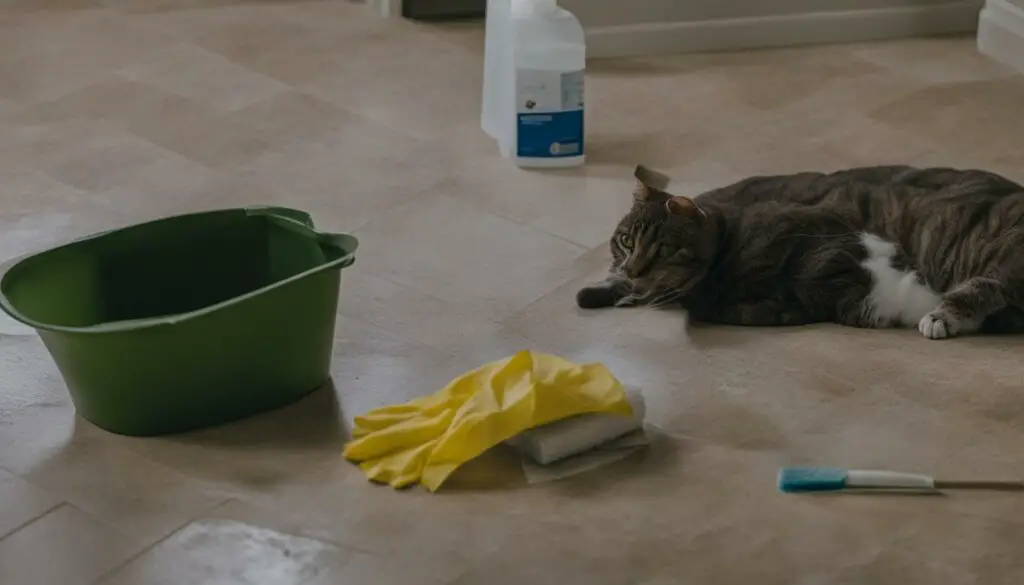
Table: Comparison of Cleaning Products
| Product | Features | Effectiveness | Price |
|---|---|---|---|
| Enzymatic Cleaner | Breaks down organic compounds | Highly effective | $$ |
| Ammonia-based Cleaner | May resemble the smell of urine | Ineffective for removing odor | $ |
| Vinegar Solution | Natural and non-toxic | Moderately effective | $ |
Note: The effectiveness and price may vary depending on the brand and concentration of the cleaning products.
Other Methods to Address Litter Box Problems and Urine Spraying
Addressing litter box problems and urine spraying requires a multi-faceted approach. In addition to the methods discussed, there are other strategies that can be implemented to discourage cats from eliminating outside the litter box and establish appropriate toileting behaviors.
Environmental Modifications
Creating an environment that is conducive to proper litter box use is crucial. One method is to use deterrents or barriers to prevent access to areas where the cat tends to eliminate. Sheets of plastic, newspaper, or sandpaper can be placed on the floor to discourage the cat from soiling those surfaces. Electronic mats or carpet runners with the prickly side up can also deter cats from certain areas.
Changing the Significance of Soiled Areas
Another approach is to change the association the cat has with previously soiled areas. Placing food bowls, treats, or toys in these spots can help shift the cat’s perception and make them less likely to eliminate there. By adding positive experiences to these areas, the cat may start to view them as positive spaces rather than places to eliminate.
Denying Access and Providing Alternatives
In some cases, denying access to certain areas altogether may be necessary. If there are specific rooms or sections of the house where the cat consistently eliminates, closing off those spaces can help break the habit. Additionally, providing alternative toileting options, such as additional litter boxes or outdoor areas for cats that are accustomed to going outside, can redirect the cat’s behavior to more appropriate locations.
| Method | Description |
|---|---|
| Environmental Modifications | Create an environment that discourages soiling in undesired areas, using deterrents or barriers. |
| Changing the Significance of Soiled Areas | Place food bowls, treats, or toys in previously soiled areas to shift the cat’s association with those spots. |
| Denying Access and Providing Alternatives | Close off areas where the cat eliminates and provide alternative toileting options. |
Importance of Consistency, Patience, and Positive Reinforcement
Consistency, patience, and positive reinforcement play vital roles in addressing litter box problems with cats. These three factors are key to establishing good habits and encouraging cats to use the litter box appropriately. By understanding and implementing these principles, cat owners can effectively manage and resolve this frustrating behavior.
Consistency is essential in maintaining a routine that cats can rely on. Providing a clean litter box regularly and ensuring its accessibility are important factors in promoting consistent litter box use. Cats are creatures of habit, and establishing a predictable routine with a consistent litter box location and cleanliness can help eliminate accidents and encourage proper elimination behavior.
Patience is crucial when dealing with litter box problems. Each cat is unique, and it may take time to identify the underlying cause of their avoidance or inappropriate elimination. It is important to remember that cats may have individual preferences and may require individualized solutions. Additionally, punishment should be avoided as it can create fear and anxiety, further exacerbating the problem. Instead, patience and understanding are key in providing a nurturing environment that encourages positive behavior.
Positive reinforcement is a powerful tool in modifying behavior. By rewarding cats for using the litter box appropriately, they can associate this behavior with positive outcomes. This can be done through praise, treats, or playtime after successful elimination. Positive reinforcement helps to establish a positive association with the litter box and encourages cats to continue using it consistently.
In conclusion, consistency, patience, and positive reinforcement are essential in addressing and resolving litter box problems with cats. By maintaining a consistent routine, being patient with individual needs, and using positive reinforcement techniques, cat owners can create an environment that promotes proper litter box use. With time and dedication, cats can learn to use the litter box consistently, improving their hygiene and overall well-being.
Understanding the Needs of Your Cat
When it comes to addressing litter box problems, it’s essential to understand the needs of your cat. Cats are sensitive creatures, and their behavior is often influenced by various factors. By taking the time to comprehend their perspective, you can better meet their needs and create an environment that promotes proper litter box usage.
Stress and changes in the cat’s environment can be significant contributors to their elimination outside the litter box. Cats thrive on consistency, so any disruptions in their routine or surroundings can lead to stress and anxiety. It’s important to provide a stable environment and minimize any potential sources of stress to help them feel secure and comfortable.
In addition to environmental factors, unmet medical or social needs can also lead to litter box problems. Cats may avoid the litter box if they are in pain due to an underlying medical condition. Regular veterinary check-ups and prompt treatment of any health issues are crucial in maintaining your cat’s well-being and preventing litter box-related problems.
| Understanding the Needs of Your Cat | Related Information |
|---|---|
| Stress and Environmental Changes | Provide a stable and stress-free environment |
| Medical and Social Needs | Regular veterinary check-ups and prompt treatment |
Remember, cats communicate their dissatisfaction or discomfort through their behavior. By understanding their needs and addressing them appropriately, you can help eliminate litter box problems and create a harmonious living environment for both you and your feline companion.
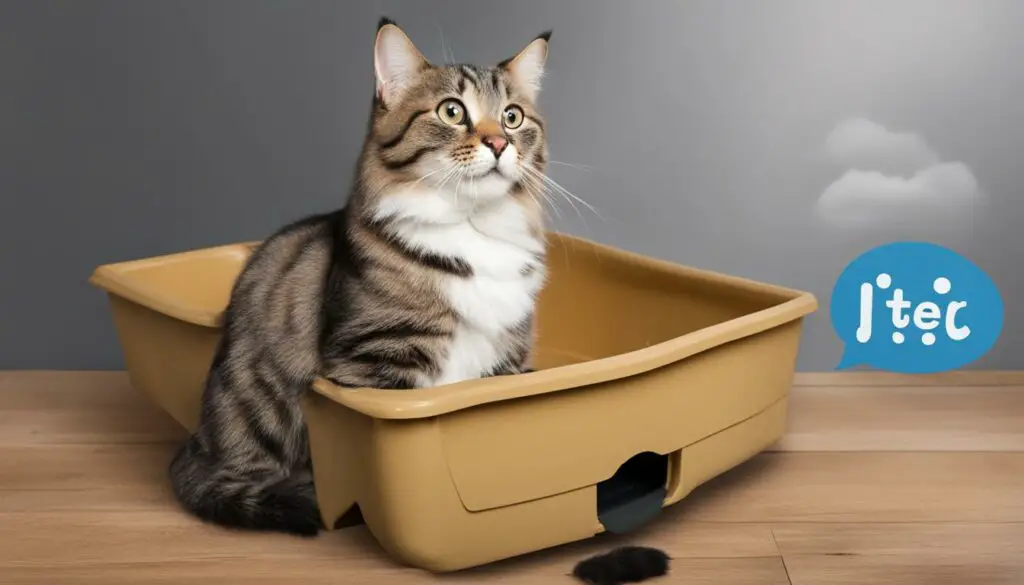
Conclusion
In conclusion, addressing litter box problems requires a proactive and patient approach. As cat owners, it’s important to understand that cats eliminate outside the litter box as a sign that their needs are not being met. By identifying the underlying causes, seeking veterinary advice, and implementing appropriate solutions, we can help our cats resolve this frustrating behavior.
Consistency is key when it comes to addressing litter box problems. Maintaining a routine, providing a clean litter box, and ensuring the cat’s environment is stress-free can go a long way in preventing accidents. Remember to avoid punishment and instead, provide positive reinforcement for using the litter box appropriately.
It’s crucial to understand that medical issues can contribute to litter box problems. By ruling out any underlying medical conditions and treating them accordingly, we can help our cats feel more comfortable and confident in using the litter box.
With understanding and persistence, our cats can be encouraged to use the litter box consistently, improving their hygiene and overall well-being. By taking the time to understand our cat’s perspective and providing appropriate solutions, we can alleviate their discomfort and create a harmonious environment for both us and our feline friends.
FAQ
Why is my cat eliminating outside the litter box?
Cats may eliminate outside the litter box due to medical problems, litter box aversions, inappropriate site preferences, or territorial marking.
What medical problems can cause litter box issues?
Medical problems like urinary tract inflammation, kidney and thyroid diseases, diabetes mellitus, and digestive tract problems can lead to litter box issues.
How can I address litter box aversions and inappropriate site preferences?
By identifying if your cat has preferences for certain surfaces or locations, you can modify the litter to match their preferences and provide multiple litter box options.
What is urine spraying and why do cats do it?
Urine spraying is a natural marking behavior in cats where they deposit small amounts of urine on vertical surfaces to establish or maintain territorial boundaries.
How can I stop litter box problems?
Maintaining a routine, providing a clean litter box, and ensuring a stress-free environment can help eliminate litter box problems. Positive reinforcement for using the litter box appropriately is also important.
How can I identify the cause of my cat’s litter box problems?
Observe if your cat has preferences for certain surfaces or locations, and make appropriate modifications to the litter box. Seeking veterinary advice to rule out medical causes is also recommended.
Are there medical treatments available for litter box problems?
Yes, there are medical treatments available to address underlying medical causes of litter box problems. However, medication should not be the only approach and should be used in conjunction with environmental changes.
How should I clean cat-soiled items?
Use cleaning products that neutralize odors rather than just deodorizing them. Avoid products containing ammonia or vinegar. Clean soiled items as soon as possible to prevent re-soiling and spraying.
What are some other methods to address litter box problems and urine spraying?
Using deterrents, denying access to certain areas, and changing the significance of soiled areas can help discourage cats from eliminating in those spots. Placing food bowls, treats, and toys in previously soiled areas can also help change associations.
How important is consistency, patience, and positive reinforcement in addressing litter box problems?
Consistency in maintaining a routine, patience in implementing solutions, and providing positive reinforcement for using the litter box appropriately are crucial in addressing litter box problems.
Why is it important to understand the needs of my cat?
Cats eliminate outside the litter box as a sign that their needs are not being met. Understanding your cat’s perspective and providing appropriate solutions can alleviate their discomfort and encourage proper litter box use.
Source Links
- https://www.vet.cornell.edu/departments-centers-and-institutes/cornell-feline-health-center/health-information/feline-health-topics/feline-behavior-problems-house-soiling
- https://kahootsfeedandpet.com/blogs/resource-center/h1-b-why-does-my-cat-potty-outside-of-the-litter-box-5-causes-and-how-to-fix-them-b-h1-p-p
- https://www.thecatvet.co.uk/house-soiling.html

